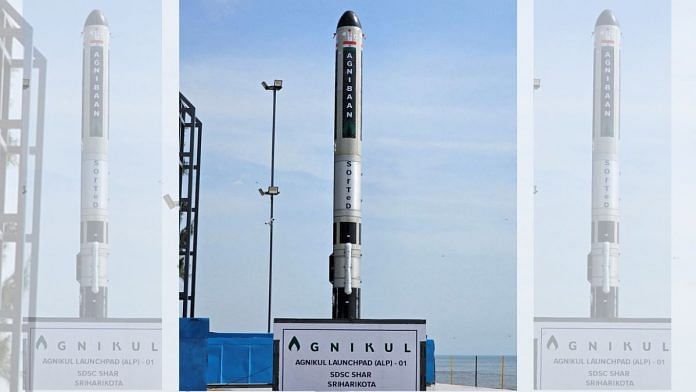New Delhi: Agnikul Cosmos, an IIT Madras-incubated space technology startup, at 7.55 am Sunday postponed the launch of Agnibaan SOrTeD (Sub Orbital Technology Demonstrator) — India’s pioneering semi-cryogenic engine-powered rocket. This was the third time over the last fortnight that the space start-up deferred the launch, citing “technical reasons’.
Agnibaan SOrTeD is a single-stage rocket powered by Agnilet semi-cryogenic engine, which is a type of rocket engine that uses a combination of liquid and gaseous propellants. These engines operate at higher temperatures compared to cryogenic engines but are cooler than the traditional liquid rocket engines.
According to Agnikul Cosmos, unlike rockets that launch from guide rails, Agnibaan SOrTeD will lift off vertically and follow a predetermined trajectory while performing a precisely orchestrated set of manoeuvres during its flight.
Responding to ThePrint’s queries about the next possible launch date, the company said that the existing errors will be fixed and a date will be decided “only after the team is convinced of all aspects.”
In a statement released Sunday evening, Agnikul Cosmos said: “Had to call off today’s (Sunday) launch attempt of Agnibaan SOrTeD just a second into Automated Launch Sequence (ALS) initiation (at T-129 seconds) because of a communication issue between two of our onboard hardware. Although it is frustrating to see a hold this close to lift off, we are glad that our ALS did its job. We’ll get to the root cause and come back for the launch after fixing the cause.”
Giving details of the “error”, an official involved in the mission told ThePrint that right before the launch, the inertial navigation system and the inertial measurement unit (IMU) failed to synchronise. The INS, which houses the IMU, is crucial for guiding the rocket’s trajectory and pinpointing its location. The IMU itself comprises various accelerometers and gyroscopes that aid in this process.
Agnibaan SOrTeD, designed to transport payloads ranging from 30 to 300 kg to orbits as high as 700 km, was set to launch from the Satish Dhawan Space Centre in Sriharikota.
The vehicle is capable of a plug-and-play engine configuration that is configurable to precisely match the mission’s needs. Simply put, since the rocket will be available for commercial missions, it can be tailored to fit the needs of the consumers.
The launch was highly anticipated as it represented several significant milestones — it is India’s first rocket with a semi-cryogenic engine, the world’s first rocket to utilise a single-piece 3D printed engine designed and built indigenously, and the inaugural launch from a privately owned pad. However, mere seconds before liftoff, the mission was aborted.
The space startup had first scheduled the launch on 22 March at 7 am but rescheduled it a day before lift-off.
People involved in the launch process said that a “minor error” was noticed during the launch rehearsal because of which the mission was rescheduled. The issue was later fixed, the company said, and a new time for the launch was decided at 6 am on 6 April.
While the company did not clarify any reason for rescheduling the launch Saturday, senior officials from the Indian Space Research Organisation (ISRO) who have been guiding private companies, such as Agnikul Cosmos to undertake independent space missions told ThePrint that this delay was probably on account of weather conditions.
The launch was promptly rescheduled for the next day once the conditions were favourable, officials confirmed. Sunday’s launch was again suspended due to the technical reasons cited by the company.
“Such things are very common. Space missions and launches are not an easy feat and many things need to be considered before a go-ahead is finally given. The point is to conduct a successful launch when everything is satisfactory,” S. Somanath, ISRO chairperson, who was present at Sriharikota spaceport for the Sunday’s launch, told ThePrint Monday.
(Edited by Richa Mishra)
Also Read: How ISRO’s PSLV Integration Facility launch at Sriharikota will help India’s space ecosystem



